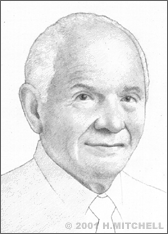Jewell Osterholm
Jewell L. Osterholm, M.D. developed a pioneering treatment for stroke and other central nervous disorders. It was based on the principle that brain food is relatively simple, composed mainly of oxygen, glucose, and amino acids.
Dr. Osterholm is a professor of neurosurgery and former chairman of the neurosurgery department at Thomas Jefferson University in Philadelphia. He realized, as did many other researchers, that when a patient has a stroke, blood flow to the brain is blocked, usually by a clot in a blood vessel, and brain tissue generally dies from the resulting lack of oxygen and other nutrients that occurs, causing irreparable damage or death. However, if it were somehow possible to get oxygen and nutrients to the brain through some sort of a “back door” while an event like this were occurring, some stroke damage could be prevented. During the precious extra time that the brain would gain from such a treatment, the body could possibly find a way to break up a clot or find its own new way to route blood to the brain.
Dr. Osterholm, whose research is focused on spinal cord injury and stroke, began studying alternative methods of treating central nervous disorders in the 1960s. He began examining the use of fluorochemical emulsions as a blood substitute in the late 1970s. After many years of research, he and a team of researchers developed a process involving drilling a hole in the skull and delivering oxygen, glucose, and amino acids through the brain using synthetic spinal fluid. In 2001, doctors at Jefferson treated its first patient with the new approach. The belief is that it could revolutionize cerebral re-oxygenation, which is crucial to reducing damage to the brain during a stroke.
In 1998, along with colleagues Rodney Bell and Glenn Frazer, Dr. Osterholm formed Neuron Therapeutics to fund trials and continue work on similar treatments. He was a board member and consultant for Neuron Therapeutics and established a research program oriented toward cerebral re-oxygenation during stroke. He also formed a weekly seminar for residents during which the neurosurgery is discussed and practical approaches to daily problems are suggested.
After earning his medical degree in 1957 from Washington University in St. Louis, Dr. Osterholm went on to serve in a number of teaching and surgical positions, mostly in or near Philadelphia. He was named inventor of the year in 1984 by the Intellectual Property Owners association and is a member of more than twenty professional medical associations.
Dr. Osterholm holds over 12 patents for his pioneering technique to improve the treatment of central nervous disorders.


